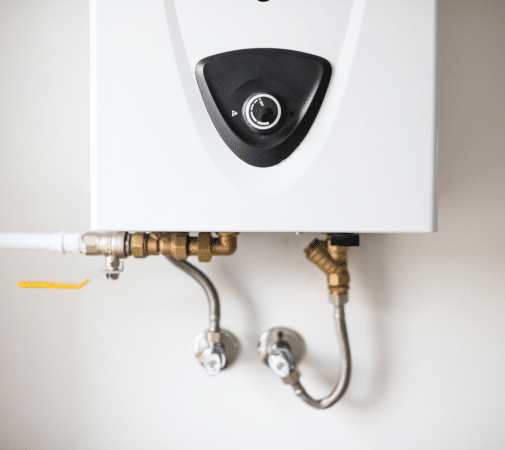Introduction
Regular maintenance of a gas tankless water heater is essential for ensuring the longevity, efficiency, and cost-effectiveness of the system. These water heaters rely on a combustion process to heat water on demand, making them a popular choice among homeowners for their energy-saving benefits and endless hot water supply.
By following a regular maintenance routine, homeowners can extend the lifespan of their gas tankless water heater, resulting in significant cost savings in the long run. Neglecting maintenance can lead to reduced performance, higher energy consumption, and even potential breakdowns or malfunctions.
Furthermore, maintaining a gas tankless water heater ensures optimal efficiency. Over time, calcium and other mineral deposits can accumulate within the unit, reducing its effectiveness and increasing fuel consumption. Regular maintenance, such as descaling the heat exchanger and flushing out the system, helps to prevent these issues and keep the water heater operating efficiently.
In conclusion, proper maintenance of a gas tankless water heater is crucial for its optimal performance, longevity, and cost-effectiveness. Regular maintenance prevents potential problems, reduces energy consumption, and saves homeowners from unexpected repair costs. By following a maintenance routine, homeowners can enjoy uninterrupted hot water supply and maximize the benefits of their gas tankless water heater.
Understanding Your Gas Tankless Water Heater
Gas tankless water heaters are becoming increasingly popular among homeowners due to their energy efficiency and endless hot water supply. Unlike traditional tank water heaters, gas tankless water heaters heat water on demand, using a powerful burner and a heat exchanger.
These water heaters work on a straightforward principle. When hot water is required, cold water enters the heater through the inlet pipe. A flow sensor detects the water flow and activates the burner. The burner then fires up, heating the heat exchanger, which transfers heat to the water. The heated water then exits the heater through the outlet pipe, providing instant hot water.
To ensure optimal performance, it is essential to perform regular maintenance on your gas tankless water heater. This includes flushing the system to remove mineral deposits and debris, inspecting the burner for any signs of damage or corrosion, and checking the venting system for blockages. Regular maintenance not only prolongs the lifespan of your water heater but also helps it operate efficiently, saving you money on energy bills.
Understanding the basic operation principles of your gas tankless water heater and the significance of maintenance will help you make the most of your investment. With proper care and regular upkeep, you can enjoy a continuous supply of hot water while maximizing energy efficiency and reliability.
Key Maintenance Tasks for Gas Tankless Water Heaters
- Regular Inspection
To ensure the efficient and reliable functioning of your gas tankless water heater, regular inspections are essential. Following a schedule for inspection can help identify any potential issues, allowing for timely maintenance and preventing costly repairs. It is recommended to inspect your unit at least once every six months.
During the inspection, there are certain signs of wear, corrosion, or leaks that homeowners should be on the lookout for. The presence of rust or corrosion on the unit, particularly around the connections or water lines, can indicate potential leaks or damage. Any signs of water or moisture around the base of the unit should also be thoroughly investigated, as they may be indicative of a leak or other issues.
In addition, homeowners should pay attention to the performance of their gas tankless water heater. Any fluctuations in water temperature or reduced water flow may indicate problems with the unit and should be addressed promptly. Similarly, unusual noises or odors coming from the unit should not be ignored and should be further investigated during the inspection.
By regularly inspecting your gas tankless water heater and promptly addressing any identified issues, homeowners can ensure the optimal performance and longevity of their systems, providing consistent hot water supply and peace of mind.
- Cleaning the Air and Water Filter
Cleaning the Air and Water Filter is crucial for maintaining the efficiency and safety of a gas tankless water heater. Over time, these filters can become clogged with debris and build-up, causing a reduction in performance and potentially leading to system malfunctions.
To clean the Air Filter, start by shutting off the power to the water heater. Locate the filter, usually located on or near the unit, and remove it carefully. Use a soft brush or vacuum cleaner to remove any dust or dirt from the filter. If the filter is heavily soiled or damaged, it may need to be replaced entirely. Refer to the manufacturer’s instructions for the appropriate replacement filter for your specific model.
When it comes to the Water Filter, begin by turning off the water supply to the unit. The location of the water filter may vary depending on the model, so consult the user manual or contact the manufacturer for guidance. Once located, carefully remove the filter and rinse it under running water to remove any sediment or debris. If the filter is damaged or worn out, it should be replaced with a new one.
Regularly cleaning or replacing both the Air and Water Filters is essential to ensure optimal performance and avoid potential breakdowns or safety hazards. Follow these step-by-step instructions to maintain your gas tankless water heater effectively.
- Flushing the System
Flushing the system of a gas tankless water heater is crucial for maintaining its performance and prolonging its lifespan. Over time, mineral deposits, such as calcium and limescale, can accumulate inside the unit, hindering its efficiency and potentially causing damage.
To safely flush your gas tankless water heater, start by turning off the power and the gas supply to the unit. Next, locate the service valves and close the cold-water supply valve. Connect a garden hose to the flushing port, ensuring a secure connection. Place the other end of the hose in a drain or outside area where the hot water can safely be discharged.
Open the purge port valve and gradually open the cold-water supply valve. Allow the water to flow through the unit and flush out any mineral buildup. It is recommended to let the water flow for approximately 20 minutes or until it runs clear. Once the flushing process is complete, close the purge port valve and remove the garden hose.
The frequency of flushing your gas tankless water heater depends on the hardness of your water. For areas with hard water, it is advisable to flush the system every six months. Those with moderately hard water should aim for flushing annually, while those with soft water may only need to flush the unit every two years.
Regularly flushing your gas tankless water heater will not only optimize its efficiency and performance but also prevent potential issues caused by mineral buildup. By following these instructions, homeowners can properly maintain their systems and enjoy reliable hot water for years to come.
- Checking the Gas Line and Ventilation
To ensure the proper functioning of your gas tankless water heater, it is crucial to regularly check the gas line and ventilation. First and foremost, inspect the gas line to ensure it is in good condition and free from any leaks or damages. Perform a visual examination of the gas line, checking for any signs of corrosion or wear. If you notice any issues, it is essential to address them promptly by contacting a professional technician.
Furthermore, it is imperative to establish secure connections between the gas line and the water heater. Ensure that all fittings are tight and properly sealed to prevent any gas leaks. Regularly monitor the connections to identify and rectify any loose or unsecured joints.
In addition to checking the gas line, verify the ventilation system of your tankless water heater. Adequate ventilation is vital to prevent the buildup of carbon monoxide, a potentially deadly gas. Ensure that the vents are clear of any obstructions, such as debris or pests, to maintain proper airflow. Regularly clean or replace air filters to ensure efficient ventilation.
By diligently checking the gas line for leaks and damages and ensuring proper ventilation, you can rest assured that your gas tankless water heater will operate efficiently and safely for years to come.
- Inspecting the Burner
The burner of a gas tankless water heater plays a crucial role in its efficient functioning. Regular inspection and maintenance of the burner are essential to ensure optimal performance and extend the lifespan of the unit.
To inspect the burner, begin by turning off the power supply and gas valve of the tankless water heater. Allow the unit to cool down before proceeding.
Remove the burner cover carefully, following the manufacturer’s instructions. Visually inspect the burner for any signs of dirt, dust, or debris buildup. Use a soft brush or vacuum cleaner to gently remove any accumulated particles from the burner surface.
Next, inspect the burner flame. A properly functioning burner should produce a stable and blue flame with minimal flickering or sputtering. If the flame appears yellow or orange, it indicates incomplete combustion, which may be due to a dirty burner or inadequate air supply. In such cases, cleaning or adjusting the burner may be necessary.
Additionally, check for any obstructions, such as spider webs or other debris, in the burner ports or venting system. These can disrupt the flow of gas and air, leading to inefficient burner operation. Use a small brush or compressed air to clear any blockages carefully.
Lastly, while inspecting the burner, also ensure that the gas supply line and connections are secure and free from leaks. Apply a mixture of soapy water to the connections and look for any bubbles, which indicate a gas leak. If there are any concerns about gas leaks or burner issues, it is recommended to seek professional assistance.
Regular inspection and maintenance of the burner will help keep your gas tankless water heater running smoothly and efficiently, providing hot water whenever you need it while prolonging its lifespan.
- Annual Professional Check-up
An annual professional check-up for your gas tankless water heater is essential to ensure optimal performance and longevity. While regular maintenance can be performed by homeowners, it is highly recommended to have a professional inspect and service the unit at least once a year to address any potential issues and keep the system running efficiently.
During a professional maintenance visit, you can expect a thorough inspection and cleaning of your gas tankless water heater. The technician will examine the various components of the system, including the heat exchanger, burner, ignition system, gas valve, and venting system. They will check for any signs of wear and tear, corrosion, or leaks. Additionally, they will clean or replace the water and gas filters as needed to prevent clogs and ensure optimal flow.
The professional will also assess the unit’s overall performance by measuring gas pressure, flame quality, and water temperature rise. They may make necessary adjustments to ensure the heater operates at the manufacturer’s specified settings. Moreover, they will test the safety features, such as the automatic shut-off mechanism, and verify proper ventilation to prevent the build-up of harmful gases, like carbon monoxide.
A professional check-up not only enhances the efficiency and reliability of your gas tankless water heater but also brings peace of mind knowing that potential issues have been addressed by a knowledgeable expert. It is a proactive approach to prevent costly breakdowns, extend the lifespan of your unit, and ensure the safety of your household.
Enhancing Efficiency and Performance
To enhance the efficiency and performance of your gas tankless water heater, there are a few key tips to follow. Firstly, it is important to adjust the settings of your water heater for seasonal changes. During the colder months, you may need to set the temperature higher to ensure a constant supply of hot water. In contrast, during warmer months, you can lower the temperature to conserve energy.
Regular maintenance is crucial for optimal performance. Be sure to clean the burner and heat exchanger regularly to remove any debris, sediment, or mineral buildup that may accumulate over time. This will help improve the efficiency of the heater and prevent any potential issues.
Inspecting the vents and air intake periodically is also important to ensure proper airflow. Blocked vents can lead to reduced performance and can even pose safety hazards. Make sure they are clear of any obstructions such as leaves, debris, or insects.
Another way to enhance efficiency is by insulating the hot water pipes. This reduces heat loss and helps deliver hot water faster. Additionally, consider installing a water softener if your area has hard water. This will prevent mineral buildup and preserve the longevity of your water heater.
By following these tips and conducting regular maintenance, you can optimize the operation of your gas tankless water heater and ensure it runs efficiently and reliably.
Conclusion
In conclusion, regular maintenance is crucial for the proper functioning of a gas tankless water heater. By following a maintenance routine, homeowners can ensure that their systems run efficiently and reliably, providing hot water whenever needed.
From flushing the system to removing mineral buildup, performing maintenance tasks can help prevent issues such as decreased water flow, reduced efficiency, or even complete system failure. By addressing these problems, homeowners can avoid costly repairs or replacement in the future.
Professional inspections are highly recommended, as they can identify any underlying issues or potential hazards that may not be noticed by the homeowner. Additionally, professionals have the necessary knowledge and tools to perform thorough maintenance tasks and keep the system in optimal condition.
However, for those who prefer to perform DIY maintenance, there are several tasks that can be done regularly. This includes checking for gas leaks, cleaning the intake air filter, and monitoring the water pressure. Homeowners should refer to the manufacturer’s guidelines and follow all safety precautions when conducting DIY maintenance.
Whether scheduling a professional inspection or engaging in DIY maintenance, homeowners should make it a priority to ensure their gas tankless water heaters are well-maintained. By doing so, they can enjoy uninterrupted hot water and prolong the lifespan of their system.






